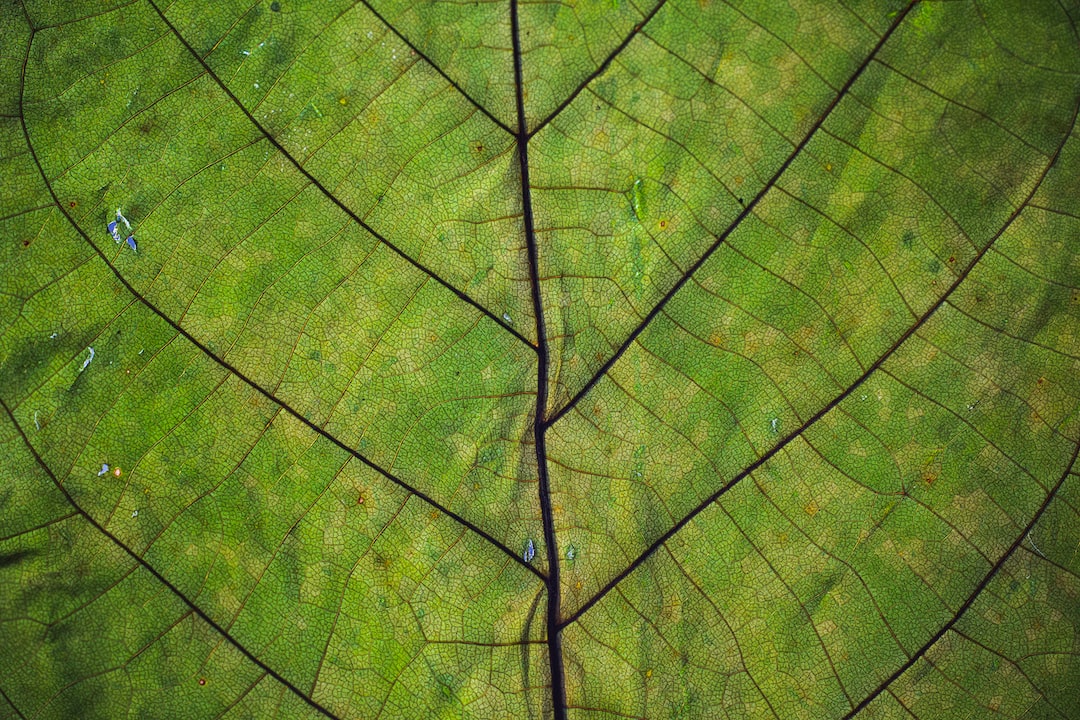The Vital Role of Chlorophyll in Photosynthesis: How Plants Convert Sunlight into Energy

Chlorophyll is a green pigment found in plants and algae that plays a crucial role in the process of photosynthesis. Photosynthesis is the process by which plants convert sunlight, carbon dioxide, and water into glucose and oxygen. This process is essential for sustaining life on Earth as it is responsible for producing the oxygen we breathe and providing the energy needed for all living organisms.
Key Takeaways
- Chlorophyll is a pigment found in plants that is essential for photosynthesis.
- Sunlight is necessary for photosynthesis to occur, as it provides the energy needed for the process.
- Chlorophyll has a unique structure that allows it to absorb light energy and convert it into chemical energy.
- During photosynthesis, light-dependent reactions occur first, followed by light-independent reactions.
- Factors such as light intensity and quality can affect the rate of photosynthesis.
The Importance of Sunlight in Photosynthesis
Sunlight is the primary source of energy for photosynthesis. Plants use sunlight to power the chemical reactions that convert carbon dioxide and water into glucose and oxygen. Sunlight contains a range of different wavelengths, with visible light being the most important for photosynthesis.
Chlorophyll is responsible for capturing sunlight and converting it into chemical energy. It absorbs light in the red and blue regions of the electromagnetic spectrum, while reflecting green light, which gives plants their characteristic green color.
The Structure and Function of Chlorophyll
Chlorophyll is a complex molecule with a structure that allows it to absorb light energy. It consists of a porphyrin ring, which contains a magnesium ion at its center, surrounded by a hydrocarbon tail. This structure allows chlorophyll to absorb light energy and transfer it to other molecules involved in photosynthesis.
The main function of chlorophyll in photosynthesis is to absorb light energy and convert it into chemical energy. When chlorophyll absorbs light, it becomes excited and transfers its energy to other molecules in the plant, such as proteins and pigments, which then use this energy to carry out the chemical reactions of photosynthesis.
The Role of Chlorophyll in Absorbing Light Energy
| Chlorophyll Type | Peak Absorption Wavelength (nm) | Function |
|---|---|---|
| Chlorophyll a | 680 | Primary pigment in photosynthesis, absorbs light energy for conversion into chemical energy |
| Chlorophyll b | 640 | Accessory pigment that transfers absorbed energy to chlorophyll a |
| Chlorophyll c | 450-630 | Found in certain algae and absorbs light energy for photosynthesis |
| Chlorophyll d | 710 | Found in certain algae and absorbs light energy for photosynthesis in low light conditions |
Chlorophyll absorbs light energy through a process called photoexcitation. When chlorophyll molecules absorb photons of light, they become excited and their electrons move to a higher energy level. This energy is then transferred to other molecules in the plant, such as proteins and pigments, which use it to carry out the chemical reactions of photosynthesis.
There are several different types of chlorophyll, with chlorophyll a and chlorophyll b being the most common in plants. Each type of chlorophyll has a specific absorption spectrum, which determines the wavelengths of light it can absorb. Chlorophyll a absorbs light most efficiently in the red and blue regions of the spectrum, while chlorophyll b absorbs light most efficiently in the blue and red-orange regions.
The Process of Photosynthesis: Light-Dependent Reactions
Photosynthesis consists of two main sets of reactions: light-dependent reactions and light-independent reactions. The light-dependent reactions occur in the thylakoid membranes of the chloroplasts and require sunlight to take place.
During the light-dependent reactions, chlorophyll absorbs light energy and uses it to split water molecules into hydrogen ions, electrons, and oxygen. The oxygen is released as a byproduct, while the hydrogen ions and electrons are used to generate ATP (adenosine triphosphate) and NADPH (nicotinamide adenine dinucleotide phosphate), which are energy-rich molecules that are used in the light-independent reactions.
The Process of Photosynthesis: Light-Independent Reactions

The light-independent reactions, also known as the Calvin cycle or dark reactions, occur in the stroma of the chloroplasts and do not require sunlight to take place. These reactions use the ATP and NADPH generated during the light-dependent reactions to convert carbon dioxide into glucose.
During the light-independent reactions, carbon dioxide is fixed into an organic molecule called RuBP (ribulose-1,5-bisphosphate) using an enzyme called RuBisCO (ribulose-1,5-bisphosphate carboxylase/oxygenase). This molecule is then converted into glucose through a series of chemical reactions.
Factors that Affect Photosynthesis: Light Intensity and Quality
Light intensity and quality are two important factors that affect the rate of photosynthesis. Light intensity refers to the amount of light available, while light quality refers to the specific wavelengths of light.
High light intensity can increase the rate of photosynthesis up to a certain point, beyond which the rate levels off. This is because at high light intensities, the plant may not be able to process all the energy it receives, leading to damage to the chlorophyll and other molecules involved in photosynthesis.
Different wavelengths of light have different effects on photosynthesis. Chlorophyll absorbs light most efficiently in the red and blue regions of the spectrum, so plants grown under red and blue light tend to have higher rates of photosynthesis compared to those grown under green or yellow light.
The Relationship between Chlorophyll and Pigments in Photosynthesis
Chlorophyll is not the only pigment involved in photosynthesis. There are several other pigments, such as carotenoids and phycobilins, that also play a role in capturing light energy.
Carotenoids are accessory pigments that absorb light in the blue and green regions of the spectrum. They help to broaden the range of wavelengths that can be absorbed by chlorophyll and protect it from damage caused by excessive light energy.
Phycobilins are pigments found in algae and cyanobacteria that absorb light in the blue and red regions of the spectrum. They play a similar role to carotenoids in capturing light energy and transferring it to chlorophyll.
The Benefits of Chlorophyll for Plants and the Environment
Chlorophyll provides several benefits for plants and the environment. Firstly, it allows plants to convert sunlight into chemical energy, which is used to carry out essential functions such as growth, reproduction, and defense against pests and diseases.
Chlorophyll also plays a crucial role in the food chain. Plants are the primary producers in most ecosystems, meaning they convert sunlight into energy that is then passed on to other organisms through the consumption of plant material. Without chlorophyll and photosynthesis, there would be no food for herbivores, and the entire ecosystem would collapse.
Furthermore, chlorophyll is responsible for producing the oxygen we breathe. During photosynthesis, plants release oxygen as a byproduct, which is then used by animals and other organisms for respiration. Without chlorophyll and photosynthesis, there would be no oxygen in the atmosphere, making life as we know it impossible.
The Potential Applications of Chlorophyll in Medicine and Industry
Chlorophyll has potential applications in medicine and industry. In medicine, chlorophyll has been used as a natural remedy for various health conditions. It has antioxidant properties and may help to protect against oxidative stress and inflammation. Chlorophyll supplements are also available and are marketed for their detoxifying and cleansing effects.
In the food industry, chlorophyll is used as a natural food coloring agent. It is added to various products, such as candies, ice creams, and beverages, to give them a green color. Chlorophyll is also used in the production of spirulina, a type of blue-green algae that is rich in protein and other nutrients.
In the cosmetic industry, chlorophyll is used in skincare products for its antioxidant properties. It is believed to help protect the skin against damage caused by free radicals and environmental pollutants.
Conclusion:
Chlorophyll is a vital pigment that plays a central role in photosynthesis. It captures sunlight and converts it into chemical energy, which is used by plants to carry out essential functions such as growth and reproduction. Without chlorophyll and photosynthesis, life on Earth as we know it would not be possible.
Chlorophyll also has potential applications in medicine and industry. It has antioxidant properties and may have health benefits when consumed or used topically. In the food industry, chlorophyll is used as a natural food coloring agent, while in the cosmetic industry, it is used in skincare products for its antioxidant properties.
Overall, chlorophyll is a fascinating molecule with a wide range of functions and potential applications. Its importance in sustaining life on Earth cannot be overstated, and further research into its properties and potential uses may lead to exciting discoveries in the future.
If you’re interested in learning more about the role of chlorophyll in photosynthesis, you might find this article from Lawn World quite informative. It delves into the fascinating process of photosynthesis and explains how chlorophyll plays a crucial role in capturing sunlight and converting it into energy for plants. To explore this topic further, check out the article here.



